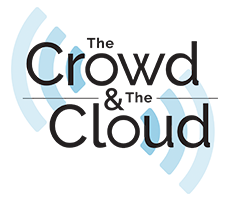
Newsletter
Sign up and stay in-the-know about The Crowd & The Cloud and the world of citizen science.


My name is Kevin Cuff, and I'm the Director of the East Bay Academy for Young Scientists, or EBAYS.
What is EBAYS?
EBAYS is an educational research program based at the Lawrence Hall of Science, at UC Berkeley. We work as an outreach program in low income communities, and communities of color throughout the East Bay and the Bay Area in general. Our mission is to provide opportunities for people to increase their understanding of scientific methodology, technology, engineering, and mathematics. Our goal is to increase their awareness of how important STEM is to their lives, and also how important it can be as a problem solving set of approaches. EBAYS has for a long time worked in communities that surround UC Berkley, so we have longstanding relationships with the schools. We go to the schools and recruit students directly from various science classes. Often, during the school year, EBAYS provides programming that is actually housed in schools.

Marbella reviews her poster with EBAYS instructor Dustin Gzresik at AGU 2015.
How has EBAYS partnered with the West Oakland Environmental Indicators Project?
We've worked with this organization because I have found that in order for us to have an impact in local communities, we have to work with those who are familiar with those communities. Rather than dropping into communities and doing either educational work or research, we work with people in those communities, and that makes our entrance into those communities a lot more smooth. The West Oakland Environmental Indicators Project has done air quality research in that particular part of Oakland for many years, as has our program, EBAYS. We've had students engaged in that kind of research for a long time as well. We conducted a study that's related to BART systems, mass transit system, here in the Bay Area. That study generated some very interesting results, so we decided to follow up on that.
What did the results from the study show?
The study essentially entails students traveling to various BART stations and ascertaining the concentration levels of particulate matter in those stations, both indoor stations and underground stations. In the past, we've found that the Embarcadero BART station, the most frequently used BART station in San Francisco, has particulate matter concentration levels through the roof, way above Environmental Protection Agency-mandated standards. That study was conducted about two years ago. We found these alarming results, and we've decided to follow up on it, especially given the fact that that study has generated interest beyond our program, interest on the part of the union that represents BART workers, as well as the Bay Area Air Quality Management District. We decided to follow up because subsequently no one else has followed up.

Taking data in the Embarcadero station.
How does the BART union and other public officials react to the work that these kids are doing?
The reaction to the work that the students have been doing over the years has been varied. As you can imagine, the agency that is charged with running BART trains and maintaining health standards at BART stations did not really respond too well to the findings that the students had generated. In fact, they were a little bit antagonistic toward the students when they had an opportunity to present their findings to BART. This was a little bit surprising to me, because I thought BART would be more receptive to this type of work being done. It provides them with information they hadn't previously had, but nevertheless the reception was not so positive.
On the other end of the spectrum, the students' work was very positively received by the union that represents the BART workers. As you can imagine if the BART workers are at stations that have high concentration levels for extended periods of time that's a significant health risk. I'd say we had a similar response from the Bay Area Air Quality Management District. They're charged with looking at air quality in the Bay area, but their lack of resources restricts them from doing the type of monitoring that our students are doing on the ground. As a result they were very receptive and very supportive.
What are the long term goals of the BART study?
We'd like to get a sense of what the air quality levels are at many BART stations throughout the Bay area. I think the problems that we're experiencing, or that we're uncovering, may exist in other cities. We're hoping that once we're able to demonstrate that there can be problems in underground mass transit systems, that other students throughout the country may become interested in doing similar work. Perhaps we can serve as a hub for an evolving network of folks throughout the country who may be interested in looking at their own local circumstances.
What role does the process of collecting scientific data have in community awareness?
The students come away with an understanding that once you have this factual information that can't be disputed, as a result of using professional equipment and protocols that are accepted by the Environmental Protection Agency, they can push policymakers to do things to perhaps mitigate some of the problems that they uncover. This is really important not only for the students' sense of themselves as being contributors to their community's health, but also in terms of education. The students come away with a better understanding of why scientific processes and practices are important. They come away with an understanding of how the facts that they're reading about in textbooks were developed. They were developed through this rigorous process which we call the scientific method.

Using the DustTrak to capture levels of particulate matter.
What role does technology have in the ability for programs like this to exist and grow in the future?
Without modern technology, I don't think we'd be able to do this type of work. In the past, the technology may have existed, but access to that technology was limited. Now, the technology has developed to such an extent that the cost has decreased significantly enough to enable community members to have access to these pieces of equipment. That's one of things that we're focused on as well, is providing community members with access to technology that will enable them to do research that will lead to policy changes a result of findings that are generated.
One of the things that makes our program successful is we offer students opportunities to use technological gadgets. The gadgets, I think, are quite a carrot for the students; we hold it in front of them and they are attracted to it! Providing them with opportunities to use gadgetry is something that has enabled us to recruit students successfully. We can expose them to technologies that they may never have experienced before, and it helps them to better understand the trajectory of technology development. By giving them more advanced technology, we give them an opportunity to start thinking about developing technology themselves. In fact, we incorporate that in our programming. The students learn about creating sensors themselves, and that gets them to thinking about developing technologies that might be applied to solving environmentally related problems that exist in their communities. Schools are not doing a good job of providing those sorts of opportunities to students, so we were able to fill that void.
Is what you’re doing considered citizen science?
I actually prefer using a different term: “community science.” The science not only benefits the communities in which it's being done but also, in most cases, the students who are doing the science are from those communities. In many cases, the projects that we're working on are community driven. It's the health of the community that's driving us to do these particular research projects. In the best of circumstances, the communities would have some input with regard to what type of research is being done in their community. As a result, I'd like to use that term, because I'd like the citizen science field to move more in that direction. I'd like the citizen science world to become more connected to the communities within which they’re working. Hopefully, by redefining the entire terminology, that may come to pass.
As a parent in the community, how do you personally feel about the work that's being done?
Fortunately, my two sons do not have any upper respiratory issues, but they have friends who do. Poor air quality is very detrimental to people who have those sorts of problems. From the perspective of a parent or a community member, I feel that this work is especially important. In many cases, while we may have regulatory agencies that are charged with taking a look at some of these issues, I know that the funding for these regulatory agencies is diminishing as we speak. As a result, I feel it's even more important for people who are of the communities to be doing this work because no one else will be doing the work and monitoring these environments.
